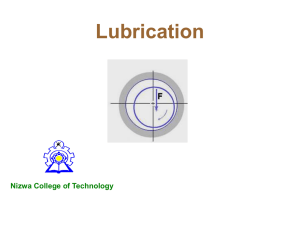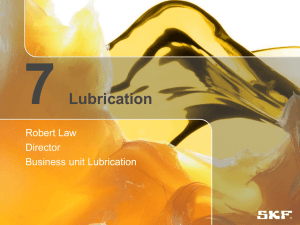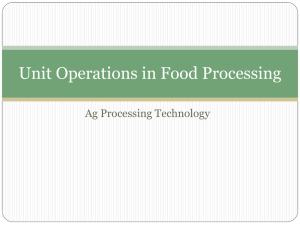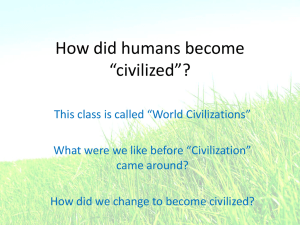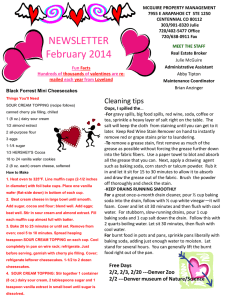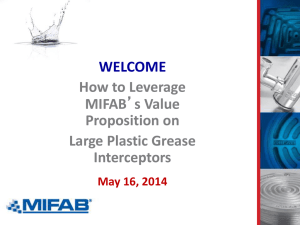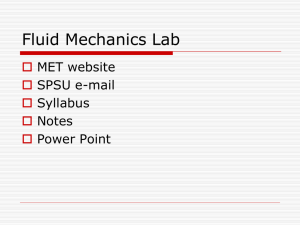Basics of Lubrication - Trainin
advertisement
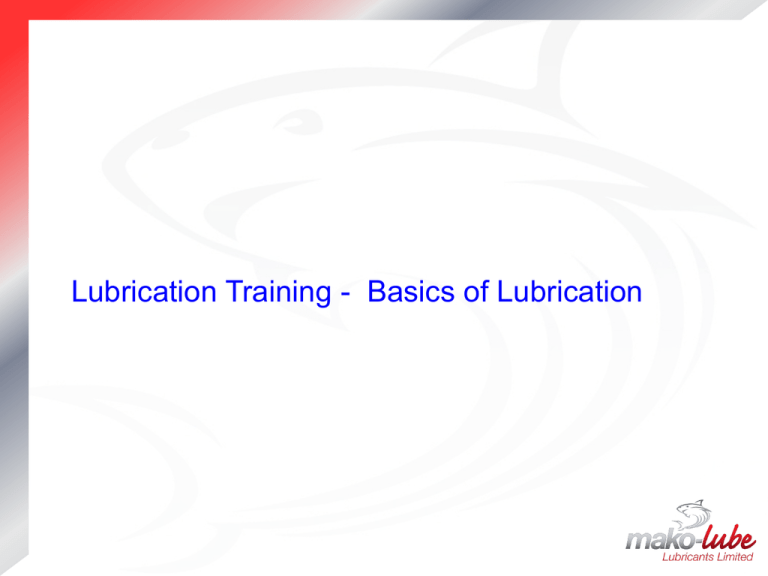
Lubrication Training - Basics of Lubrication Types of Lubrication Hydrodynamic Boundary Mixed Hydrodynamic Lubrication Occurs when machine parts are completely separated by a full and continuous film of lubricant Contact between the parts does not occur. Full-fluid-film lubrication is hydrodynamic lubrication, the oil adheres to the moving part and is drawn into the area between the rotating surfaces, where it forms a pressure, or hydrodynamic, wedge. A less common form of full-fluid-lubrication is hydrostatic lubrication, where the oil is supplied to the bearing area under pressure to separate the sliding surfaces. Hydrodynamic Lubrication Boundary Lubrication Under certain conditions such as shock loading, heavy loads, high temperature, slow speed and critically low viscosity, the lubricant is no longer hydrodynamic Frequent contact between the surfaces, resulting in a significant rise in temperature and subsequent destruction of the contacting surfaces. Under these circumstances, the fluid film is no longer capable of adequately protecting the surfaces. EP capabilities in the lubricant are essential Solid additives are mixed into the grease Mixed Lubrication Although not a true “mode” of lubrication in the sense of hydrodynamic or boundary, mixed lubrication occurs more frequently then is realized. Mixed lubrication is a transitional mode of lubrication between hydrodynamic and boundary Mixed lubrication is characterized by the likelihood of intermittent surface contact EP and anti-wear are essential properties in the lubricant How is a lubricant made? Select a base fluid: MINERAL OIL or SYNTHETIC FLUID? Selecting a base fluid: MINERAL OIL Paraffinic or Naphthenic Readily available Comparatively low cost Limited performance. Selecting a base fluid: SYNTHETIC FLUIDS PAO, PAG, Ester Synthetically manufactured Comparatively high cost Improved performance Longevity Temperature Viscosity Index Selecting a base fluid: OTHER SYNTHETIC FLUIDS Silicones Fluorinated Ultra Performance Ultra Temperature Long Life Lube for Life Base fluid selected: Mineral or Synthetic NOW SELECT THE REQUIRED VISCOSITY. Selecting the required viscosity: Generally thinner fluids are used for: Lighter loads Faster speeds. Selecting the required viscosity: Generally thicker fluids are used for: Heavier loads Slower speeds So how do we measure viscosity?. 400C & 1000C mm2 per second =centistokes (cSt) High Low Viscosity (Thin) Viscosity (Thick) What are the units of viscosity? mm2s = centistokes (cSt) = ISO VG (at 400C) 32 cSt - typical low viscosity (thin) 680 cSt - typical high viscosity (thick) ISO VG 15-22-32-46-68-100-150-220-320-460-680-1000 etc Product enhancements: Extreme Pressure (EP) Additives CHEMICAL SOLUTIONS Chlorine Sulphur Phosphorous SOLID LUBRICANTS Graphite Molybdenum disulphide (MoS2) PTFE (Teflon) Product enhancements OXIDATION INHIBITORS Longer wet life CORROSION INHIBITORS Improves corrosion protection. TACKY ADDITIVES Improves adhesion Thickener Systems – turn fluids into greases Improved Performance -Temperature -Mechanical stability General Purpose Soap Thickeners Lithium complex Calcium complex Aluminium complex Lithium soap Calcium soap Aluminium soap Thickener Properties Lithium Good multi-purpose, good mechanical stability, limited other properties Lithium Complex Excellent high temp & mechanical stability capability Calcium Complex Excellent load carrying and water resistance Aluminium Complex Excellent temperature capability & water resistance Other Thickener Systems Other grease thickeners: Bentonite clay Silica PTFE. How is the grease thickness checked ? NLGI PENETRATION TEST NATIONAL LUBRICATING GREASE INSTITUE of America. NLGI Numbers - WHAT DO THEY MEAN? NLGI No 6 BLOCK GREASE Old Technology NLGI No 5 SEMI-SOLID ELASTIC-LIKE GREASE Very rarely used, but can be found in marine or shipping applications NLGI No 4 VERY TACKY GREASE Rarely used now, but found sometimes found in heavy open gears or mining equipment NLGI No 3 HEAVIER GREASE Used mainly for hand applied or caulking guns NLGI No 2 85% OF MARKET Generally used in grease guns NLGI No 1 THINNER GREASE Generally used in grease guns, slightly more pump- able for short pipe lines NLGI No 0 TREACLE LIKE GREASE Used in semi-auto and auto systems with shorts pipelines SEMI FLUID/ NLGI No 00 SEMI FLUID GREASE FLUID GREASE NLGI No 000 FLUID GREASE Generally applied by Used in semi-auto and automatic systems Automatic Lubricator Used in some gearboxes and semi & auto lube systems with longer pipe lines HOW IS GREASE THICKNESS MEASURED? Premium EP 2 NLGI 6 NLGI 5 NLGI 4 NLGI 3 NLGI 2 NLGI 1 NLGI 0 NLGI 00 NLGI 000 Premium EP 1 Premium EP 000 Summary Base fluid Mineral or synthetic Viscosity EP additives Chemical and/or solids Corrosion inhibitors Oxidation inhibitors Thickeners for greases. BASIC FUNCTION OF A PRECISION BEARING TO SUPPORT A ROTATING SHAFT Outer Race Balls or Rollers Shaft Inner Race Lubricant BASIC FUNCTION OF A PLAIN BEARING TO SUPPORT A ROTATING SHAFT Plain Bush Lubricant Shaft BASIC FUNCTION OF A SLIDE TO SUPPORT A SLIDING LOAD ALL BEARINGS/SLIDES HAVE ONE SURFACE MOVING AGAINST ANOTHER FRICTIONAL HEAT WHY LUBRICATE? FRICTIONAL HEAT FRICTIONAL WEAR WHY LUBRICATE? Introduction of a lubricant film REDUCES FRICTIONAL HEAT & WEAR BASIC FUNCTION OF A LUBRICANT. Reasons for bearing failure Other reasons 21% Improper mounting 27% Improper lubrication 43% Material fatigue 9% Breakdown of “improper lubrication” section Over lubrication 60% Lack of lubrication 40% Potential failures due to over lubrication Standard grease gun can develop 3,000 psi High pressure grease guns can develop >6,000 psi Potentially resulting in excessive drag causing: Increased power demand Ball/roller skid Increased friction Excessive heat Excessive race wear Degradation of the lubricant. Correct Application of a lubricant LITTLE & OFTEN! Precision Bearings: Typically fill 1/3 to 1/2 of vacant area in bearing High speed bearings require approx. 1/3 fill Plain Bearings Typically fill until clean grease shows. Thank You Any Questions?
